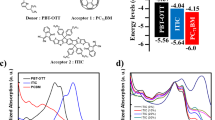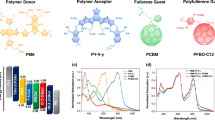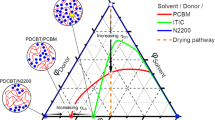Abstract
The use ternary organic components is currently being pursued to enhance the power conversion efficiency of bulk heterojunction solar cells by expanding the spectral range of light absorption. Here, we report a ternary blend polymer solar cell containing two donor polymers, poly-3-oxothieno[3,4-d]isothiazole-1,1-dioxide/benzodithiophene (PID2), polythieno[3,4-b]-thiophene/benzodithiophene (PTB7) and [6,6]-phenyl C71 butyric acid methyl ester (PC71BM) as an acceptor. The resulting ternary solar cell delivered a power conversion efficiency of 8.22% with a short-circuit current density Jsc of 16.8 mA cm–2, an open-circuit voltage Voc of 0.72 V and a fill factor of 68.7%. In addition to extended light absorption, we show that Jsc is improved through improved charge separation and transport and decreased charge recombination, resulting from the cascade energy levels and optimized device morphology of the ternary system. This work indicates that ternary blend solar cells have the potential to surpass high-performance binary polymer solar cells after further device engineering and optimization.
This is a preview of subscription content, access via your institution
Access options
Subscribe to this journal
Receive 12 print issues and online access
$209.00 per year
only $17.42 per issue
Buy this article
- Purchase on Springer Link
- Instant access to full article PDF
Prices may be subject to local taxes which are calculated during checkout





Similar content being viewed by others
References
Son, H. J., He, F., Carsten, B. & Yu, L. P. Are we there yet? Design of better conjugated polymers for polymer solar cells. J. Mater. Chem. 21, 18934–18945 10.3389/fchem.2013.00035(2011).
He, F. & Yu, L. P. How far can polymer solar cells go? In need of a synergistic approach. J. Phys. Chem. Lett. 2, 3102–3113 (2011).
Thompson, B. C. & Frechet, J. M. J. Organic photovoltaics—polymer–fullerene composite solar cells. Angew. Chem. Int. Ed. 47, 58–77 (2008).
Liang, Y. Y. & Yu, L. P. A new class of semiconducting polymers for bulk heterojunction solar cells with exceptionally high performance. Acc. Chem. Res. 43, 1227–1236 (2010).
Liang, Y. Y. et al. For the bright future-bulk heterojunction polymer solar cells with power conversion efficiency of 7.4%. Adv. Mater. 22, E135–E138 10.1002/adma.200903528(2010).
Son, H. J. et al. Synthesis and photovoltaic effect in dithieno[2,3-d:2′,3′-d′]benzo[1,2-b:4,5-b′]dithiophene-based conjugated polymers. Adv. Mater. 25, 838–843 (2013).
Small, C. E. et al. High-efficiency inverted dithienogermole–thienopyrrolodione-based polymer solar cells. Nature Photon. 6, 115–120 (2012).
Price, S. C., Stuart, A. C., Yang, L. Q., Zhou, H. X. & You, W. Fluorine substituted conjugated polymer of medium band gap yields 7% efficiency in polymer-fullerene solar cells. J. Am. Chem. Soc. 133, 4625–4631 10.1021/ja1112595(2011).
Chu, T. Y. et al. Bulk heterojunction solar cells using thieno 3,4-c pyrrole-4,6-dione and dithieno[3,2-b:2′,3′-d]silole copolymer with a power conversion efficiency of 7.3%. J. Am. Chem. Soc. 133, 4250–4253 (2011).
Piliego, C. et al. Synthetic control of structural order in N-alkylthieno 3,4-c pyrrole-4,6-dione-based polymers for efficient solar cells. J. Am. Chem. Soc. 132, 7595–7597 (2010).
Peet, J. et al. Efficiency enhancement in low-bandgap polymer solar cells by processing with alkane dithiols. Nature Mater. 6, 497–500 (2007).
Lee, J. K. et al. Processing additives for improved efficiency from bulk heterojunction solar cells. J. Am. Chem. Soc. 130, 3619–3623 (2008).
Lu, L. et al. The role of N-doped multiwall carbon nanotubes in achieving highly efficient polymer bulk heterojunction solar cells. Nano Lett. 13, 2365–2369 10.1021/nl304533j(2013).
Seo, J. H. et al. Improved high-efficiency organic solar cells via incorporation of a conjugated polyelectrolyte interlayer. J. Am. Chem. Soc. 133, 8416–8419 10.1021/ja2037673(2011).
He, Z. C. et al. Simultaneous enhancement of open-circuit voltage, short-circuit current density, and fill factor in polymer solar cells. Adv. Mater. 23, 4636–4643 (2011).
Kim, J. Y. et al. Efficient tandem polymer solar cells fabricated by all-solution processing. Science 317, 222–225 (2007).
He, Z. C. et al. Enhanced power-conversion efficiency in polymer solar cells using an inverted device structure. Nature Photon. 6, 591–595 10.1038/nphoton.2012.190(2012).
Koster, L. J. A., Mihailetchi, V. D. & Blom, P. W. M. Ultimate efficiency of polymer/fullerene bulk heterojunction solar cells. Appl. Phys. Lett. 88, 093511 (2006).
Scharber, M. C. et al. Design rules for donors in bulk-heterojunction solar cells—towards 10% energy-conversion efficiency. Adv. Mater. 18, 789–794 (2006).
Honda, S., Ohkita, H., Benten, H. & Ito, S. Selective dye loading at the heterojunction in polymer/fullerene solar cells. Adv. Energy Mater. 1, 588–598 (2011).
Honda, S., Ohkita, H., Benten, H. & Ito, S. Multi-colored dye sensitization of polymer/fullerene bulk heterojunction solar cells. Chem. Commun. 46, 6596–6598 (2010).
Huang, J. S. et al. Polymer bulk heterojunction solar cells employing Forster resonance energy transfer. Nature Photon. 7, 480–486 (2013).
Koppe, M. et al. Near IR sensitization of organic bulk heterojunction solar cells: towards optimization of the spectral response of organic solar cells. Adv. Funct. Mater. 20, 338–346 (2010).
Ameri, T. et al. Performance enhancement of the P3HT/PCBM solar cells through NIR sensitization using a small-bandgap polymer. Adv. Energy Mater. 2, 1198–1202 (2012).
Khlyabich, P. P., Burkhart, B. & Thompson, B. C. Compositional dependence of the open-circuit voltage in ternary blend bulk heterojunction solar cells based on two donor polymers. J. Am. Chem. Soc. 134, 9074–9077 10.1021/ja302935n(2012).
Yang, L., Zhou, H., Price, S. C. & You, W. Parallel-like bulk heterojunction polymer solar cells. J. Am. Chem. Soc. 134, 5432–5435 10.1021/ja211597w(2012).
Cha, H. et al. Complementary absorbing star-shaped small molecules for the preparation of ternary cascade energy structures in organic photovoltaic cells. Adv. Funct. Mater. 23, 1556–1565 (2013).
Itskos, G. et al. Optical properties of organic semiconductor blends with near-infrared quantum-dot sensitizers for light harvesting applications. Adv. Energy Mater. 1, 802–812 (2011).
De Freitas, J. N. et al. The effects of CdSe incorporation into bulk heterojunction solar cells. J. Mater. Chem. 20, 4845–4853 10.1039/C0JM00191K(2010).
Belcher, W. J., Wagner, K. I. & Dastoor, P. C. The effect of porphyrin inclusion on the spectral response of ternary P3HT:porphyrin:PCBM bulk heterojunction solar cells. Solar Ener. Mater. Solar Cells 91, 447–452 10.1016/j.solmat.2006.09.007(2007).
Cooling, N. et al. A study of the factors influencing the performance of ternary MEH-PPV:porphyrin:PCBM heterojunction devices: a steric approach to controlling charge recombination. Solar Ener. Mater. Solar Cells 95, 1767–1774 10.1016/j.solmat.2011.01.046(2011).
Machui, F., Rathgeber, S., Li, N., Ameri, T. & Brabec, C. J. Influence of a ternary donor material on the morphology of a P3HT:PCBM blend for organic photovoltaic devices. J. Mater. Chem. 22, 15570–15577 10.1039/C2JM31882B(2012).
Hu, Z. J., Tang, S., Ahlvers, A., Khondaker, S. I. & Gesquiere, A. J. Near-infrared photoresponse sensitization of solvent additive processed poly(3-hexylthiophene)/fullerene solar cells by a low band gap polymer. Appl. Phys. Lett. 101, 053308 (2012).
Huang, J. H., Velusamy, M., Ho, K. C., Lin, J. T. & Chu, C. W. A ternary cascade structure enhances the efficiency of polymer solar cells. J. Mater. Chem. 20, 2820–2825 (2010).
Ameri, T., Khoram, P., Min, J. & Brabec, C. J. Organic ternary solar cells: a review. Adv. Mater. 25, 4245–4266 (2013).
Lu, L. Y., Luo, Z. Q., Xu, T. & Yu, L. P. Cooperative plasmonic effect of Ag and Au nanoparticles on enhancing performance of polymer solar cells. Nano Lett. 13, 59–64 (2013).
Wu, J. L. et al. Surface plasmonic effects of metallic nanoparticles on the performance of polymer bulk heterojunction solar cells. ACS Nano 5, 959–967 10.1021/nn102295p(2011).
Schilinsky, P., Waldauf, C. & Brabec, C. J. Recombination and loss analysis in polythiophene based bulk heterojunction photodetectors. Appl. Phys. Lett. 81, 3885 (2002).
Riedel, I. et al. Effect of temperature and illumination on the electrical characteristics of polymer-fullerene bulk-heterojunction solar cells. Adv. Funct. Mater. 14, 38–44 (2004).
Goh, C., Kline, R. J., McGehee, M. D., Kadnikova, E. N. & Frechet, J. M. J. Molecular-weight-dependent mobilities in regioregular poly(3-hexyl-thiophene) diodes. Appl. Phys. Lett. 86, 122110 (2005).
Fang, G. et al. Improving the nanoscale morphology and processibility for PCDTBT-based polymer solar cells via solvent mixtures. Org. Electron. 13, 2733–2740 10.1016/j.orgel.2012.08.003(2012).
Hendriks, K. H., Heintges, G. H. L., Gevaerts, V. S., Wienk, M. M. & Janssen, R. A. J. High-molecular-weight regular alternating diketopyrrolopyrrole-based terpolymers for efficient organic solar cells. Angew. Chem. Int. Ed. 52, 8341–8344 10.1002/anie.201302319(2013).
Lu, X. et al. Bilayer order in a polycarbazole-conjugated polymer. Nature Commun. 3, 795 (2012).
Smilgies, D.-M. Scherrer grain-size analysis adapted to grazing-incidence scattering with area detectors. J. Appl. Crystallogr. 42, 1030–1034 (2009).
Chen, W., Nikiforov, M. P. & Darling, S. B. Morphology characterization in organic and hybrid solar cells. Energy Environ. Sci. 5, 8045–8074 (2012).
Chen, W. et al. Hierarchical nanomorphologies promote exciton dissociation in polymer/fullerene bulk heterojunction solar cells. Nano Lett. 11, 3707–3713 (2011).
Acknowledgements
This work is supported by the US National Science Foundation (NSF, grant no. NSF CHE-1229089, DMR-1263006), the Air Force Office of Scientific Research and NSF MRSEC programme at the University of Chicago, the DOE via the ANSER Center, an Energy Frontier Research Center funded by the US Department of Energy, Office of Science, Office of Basic Energy Sciences (award no. DE-SC0001059). W.C. acknowledges financial support from the US Department of Energy, Office of Science, Office of Basic Energy Sciences (award no. KC020301). The authors thank J. Strzalka and C. Wang for assistance with GISAXS and RSoXS measurements. Use of the Advanced Photon Source (APS) at Argonne National Laboratory was supported by the US Department of Energy, Office of Science, Office of Basic Energy Sciences (contract no. DE-AC02-06CH11357). The ALS at Lawrence Berkeley National Laboratory is supported by the Director, Office of Science, Office of Basic Energy Sciences, of the US Department of Energy (contract no. DE-AC02-05CH11231).
Author information
Authors and Affiliations
Contributions
L.Y. conceptualized the project. L.L. designed and performed the device experiments and data analysis. T.X. performed materials synthesis. L.L. characterized film morphology by TEM and AFM. W.C. and E.L. performed X-ray scattering experiments and analyses. All authors discussed the results and L.Y., L.L. and W.C. wrote the manuscript.
Corresponding author
Ethics declarations
Competing interests
The authors declare no competing financial interests.
Supplementary information
Supplementary information
Supplementary information (PDF 1097 kb)
Rights and permissions
About this article
Cite this article
Lu, L., Xu, T., Chen, W. et al. Ternary blend polymer solar cells with enhanced power conversion efficiency. Nature Photon 8, 716–722 (2014). https://doi.org/10.1038/nphoton.2014.172
Received:
Accepted:
Published:
Issue Date:
DOI: https://doi.org/10.1038/nphoton.2014.172
This article is cited by
-
Highly efficient ternary organic solar cells with excellent open-circuit voltage and fill factor via precisely tuning molecular stacking and morphology
Science China Chemistry (2024)
-
Splashing of tungsten-based anode during arc discharge
Scientific Reports (2023)
-
Models and mechanisms of ternary organic solar cells
Nature Reviews Materials (2023)
-
Ternary solvent strategy enhancing the photovoltaic performance of ternary polymer solar cells
Journal of Materials Science: Materials in Electronics (2023)
-
Single-junction organic solar cells with over 19% efficiency enabled by a refined double-fibril network morphology
Nature Materials (2022)



